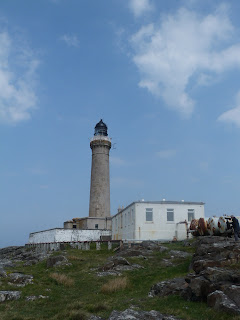 |
| Ardnamurchan Lighthouse |
 |
| The now redundant fog signal trumpet |
On board the ferry one of the crew members said on the previous trip they had stopped the ferry to let a school of dolphins swim clear, but no such luck for us! We think all the wild life on Mull are playing hide and seek with us though last week we did see an otter swimming past our local beach!
Alan Stevenson built the lighthouse between 1845 and 1849. It stands on flat rock about twenty metres above the sea on an otherwise mountainous peninsular at the most westerly point of mainland Britain. The granite that the thirty-six metre high tower was built from came by boat from the southern end of Mull and was landed on a temporary pier. The large lens, one of the first hyperadial ones, is now in the visitor centre as it was replaced in recent years by sealed beam units. The keepers were also replaced by automated equipment and the careful husbandry of the keepers and their families notable by its absence as the lighthouse now has a neglected appearance that belies its efficient service to passing mariners in a area noted for bad weather and fast flowing tidal streams. A wildlife watcher with his large ‘scope reported plenty of birds to be seen but not a single porpoise, dolphin or whale in sight. Maybe better luck on the way home!!
 |
| The only ferry passengers! |












